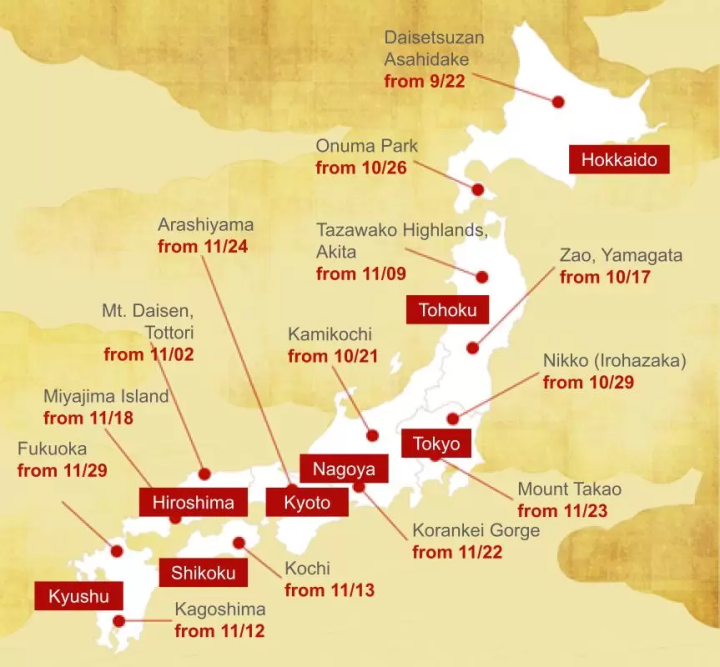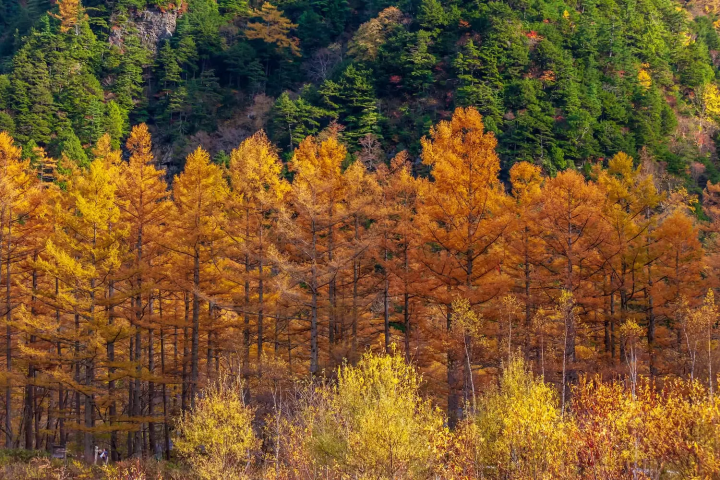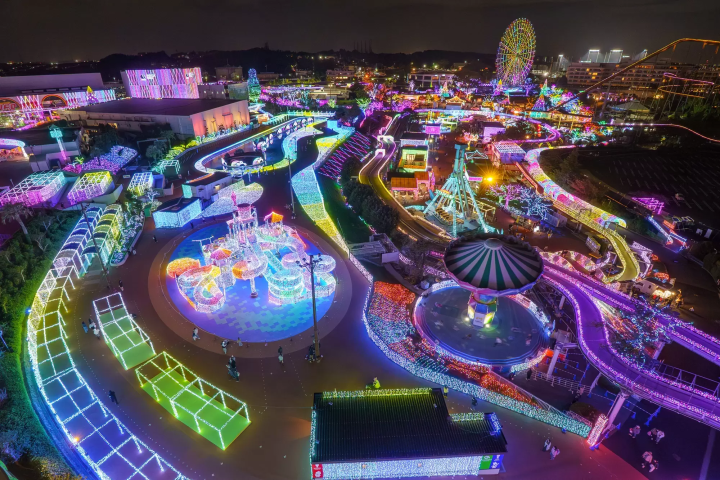Kamikochi in Autumn: 5 Fall Foliage Spots and Travel Tips

The autumn foliage season in Kamikochi begins in late September, with peak times from mid-October to early November. Learn the best fall foliage spots, including Kappa Bridge and Taisho Pond, along with travel tips.
Autumn Foliage in Kamikochi

The autumn foliage in Nagano's Kamikochi area starts early, with the colors at Karasawa, located high up in the mountains, reaching their peak in late September and gradually changing colors as it moves down to the foothills.
By mid-October, the maple trees, rowan trees, and larch beautifully change color, enhancing the scenery along the Hodaka mountain range and the Azusa River.
In late October, as snow begins to accumulate on the mountain peaks, visitors may have the fortunate opportunity to enjoy a rare experience of the contrast between autumn leaves and snow, which is a unique charm of autumn in Kamikochi.
Kamikochi in Autumn
1. The Best Time to See the Autumn Foliage in Kamikochi
2. 5 Beautiful Autumn Foliage Spots in Kamikochi
3. Autumn Travel Tips for Kamikochi
4. How to Get to Kamikochi
Read also
The Best Time to See the Autumn Foliage in Kamikochi
The best time to see the autumn foliage in Kamikochi is generally said to be from mid-October to early November, and here are the characteristics for each period.
Mid-October
This is when the autumn foliage truly begins in Kamikochi. In the higher altitudes, the Japanese white birch and rowan trees beautifully change color, while broadleaf trees like maples and white birches gradually start to show their autumn hues.
Highlights include the areas around Kappa Bridge and Myojin Pond, where you can enjoy the views of trees dyed in yellow and red alongside clear streams and mountain landscapes.
Late October
This is when the autumn foliage reaches its peak. Kamikochi becomes vibrantly colored, and the contrast with the surrounding mountains becomes even more beautiful. This season offers splendid views to truly enjoy the scenery.
Highlights include Taisho Pond (where the autumn leaves reflecting on the surface alongside Mt. Yake create a stunning sight) and the path along the Azusa River (perfect for leisurely walks while enjoying the golden larch foliage).
Early November
This marks the end of the autumn foliage season, with leaves gradually falling. However, in lower areas and valleys, some autumn colors remain, allowing you to enjoy the late autumn scenery. You can also see the snow-capped Hodaka mountains.
Highlights include the larch forest along the Azusa River, as well as the beautiful scenery created by the leaves and fallen foliage around Tokuzawaen.
5 Beautiful Autumn Foliage Spots in Kamikochi
Here are five recommended spots known for their autumn foliage in Kamikochi.
All spots are open 24 hours and free of charge, but entry by private car is prohibited (for more details, please see "Access to Kamikochi").
1. Kappa Bridge

Photo by Pixta
Kappa Bridge is an iconic spot in Kamikochi, and during the autumn foliage season, you can enjoy the vibrant trees and the beautiful flow of the Azusa River against the backdrop of the Hodaka mountain range and Mt. Yake.
The peak foliage period is from mid to late October, when the rowan trees, maples, and Japanese white birch turn shades of red and yellow, creating a stunning contrast with the clear emerald-green waters of the Azusa River.
Kappa Bridge is located just a 5-minute walk from the Kamikochi Bus Terminal, and the walking paths are well-maintained, allowing you to leisurely enjoy the autumn scenery while listening to the gentle sounds of the Azusa River.
Of course, it's highly recommended to take photos not only from Kappa Bridge but also with the bridge in the background!
2. Taisho Pond

Photo by Pixta
Taisho Pond is particularly popular as a serene and beautiful autumn foliage spot in Kamikochi. The pond was formed when the Azusa River was dammed by the eruption of Mt. Yake (Yakedake) in 1915, and you can still see dead trees standing in the lakebed, creating a mystical landscape.
The best time to see the autumn foliage here is from mid to late October. On clear days, the surrounding foliage, along with Mt. Yake and the Hodaka mountain range, reflects beautifully on the lake's surface, offering a breathtaking view.
In the early morning, a misty and enchanting scene unfolds, making it a famous spot for photography.
There is also a walking path of about 2.5 kilometers around Taisho Pond, so if you have time, consider taking a leisurely stroll to fully experience nature!
3. Tashiro Pond

Photo by Pixta
Tashiro Pond is a shallow pond with high transparency, set amid pristine forests, featuring a landscape characterized by progressing wetlands. The best time to see the autumn foliage here is from mid to late October.
The islands scattered throughout the pond create a rice field-like landscape, and during the foliage season, the beautiful autumn colors reflected on the pond’s surface create a magical scene. Sediments washed in by typhoons and heavy rain have accumulated, transforming the area into wetlands.
Formed by the eruption of Mt. Yake, this pond is a spot where you can enjoy a tranquil and serene wetland landscape. It is accessible by walking about 40 minutes from Kamikochi Bus Terminal in the opposite direction of Kappa Bridge.
4. Myojin Pond

Photo by Pixta
Myojin Pond is a mystical site comprised of two ponds, Ichinokai and Ninokai, located at an elevation of 1,530 meters within the grounds of the Hodaka Shrine's Okumiya. This area is considered sacred and holds religious significance.
The best time to admire the autumn foliage here is from mid to late October, when the clear surface of the pond reflects Myojin Peak and the colorful autumn trees, creating a beautiful landscape.
In the early morning, mist often blankets the area, enhancing the enchanting atmosphere. The spot is also known for its crystal-clear water that does not freeze in winter, showcasing the beauty of nature’s sculptural forms.
There are two routes to reach Myojin Pond: The first route involves walking upstream along the left bank of the Azusa River from Kappa Bridge, passing through Konashidaira and the Visitor Center, crossing Myojin Bridge to reach the pond.
The second route starts at Kappa Bridge, following the right bank of the Azusa River upstream, passing the Gakezawa Wetlands, and then turning left onto the walking path before Myojin Bridge to arrive at Myojin Pond.
Both routes are accessible in about one hour by foot from Kappa Bridge.
5. Larch Forest along the Left Bank of Azusa River

Photo by Pixta
The larch forest along the left bank of the Azusa River spreads out along the walking paths in Kamikochi, reaching its peak with beautiful golden larch leaves from late October to early November. Larch trees turn golden in the autumn, and the sight of their fallen leaves carpeting the ground is also a stunning view.
Notable spots for viewing the larch forest include the area around the bus terminal and Konashidaira Campground.
If you start walking from Tashiro Bridge, located south of Kappa Bridge, toward the bus terminal, you'll enjoy a picturesque line of larch trees in the distance.
At Konashidaira Campground, you can see the larch trees' golden colors against the backdrop of the surrounding Rokko Mountain and the Hodaka mountain range, offering a quintessential Kamikochi landscape.
Additionally, since Kamikochi experiences shorter daylight hours, it's recommended to visit between 10:00 and 15:00 for the best sunlight to enjoy the larch foliage!
Autumn Travel Tips for Kamikochi
The autumn foliage season in Kamikochi (from mid-October to early November) sees peak congestion, especially on weekends and holidays.
The areas around Kappa Bridge, Taisho Pond, and the Kamikochi Bus Terminal tend to attract a lot of visitors, resulting in longer wait times for parking and shuttle buses.
At the Kamikochi Bus Terminal, they may distribute numbered tickets during busy times. It has also been reported that on peak foliage weekends, the parking lots may be full as early as 5 to 6 AM.
If you plan to visit during the foliage season on weekends or holidays by car, make sure to arrive early in the morning.
To avoid congestion, it is recommended to visit on weekdays or early in the morning. Since shuttle buses run every 30 minutes, be mindful of the schedule and aim to leave early to avoid getting caught in the return congestion!
How to Get to Kamikochi

Photo by Pixta
Kamikochi prohibits entry by private car to protect its natural environment, so visitors must use public transportation or shuttle buses to access the area. Below are the different access methods.
Accessing Kamikochi by Public Transportation
This method involves a combination of train and bus travel.
From Tokyo
Via Matsumoto Station
Tokyo Station → Matsumoto Station (Using the JR Chuo Line Limited Express "Azusa" or "Shinano")
Duration: Approximately 2 hours and 30 minutes
Matsumoto Station → Shinshimashima Station (Alpico Kotsu Kamikochi Line)
Duration: Approximately 30 minutes
Shinshimashima Station → Kamikochi (Alpico Kotsu bus to Kamikochi Bus Terminal)
Duration: Approximately 1 hour
Via Shinjuku Station
Shinjuku Station → Matsumoto Station (JR Limited Express "Azusa")
Duration: Approximately 2 hours and 30 minutes
From Matsumoto Station, proceed to Kamikochi (by bus, approximately 1 hour)
From Nagoya
Nagoya Station → Matsumoto Station (JR Limited Express "Shinano")
Duration: Approximately 2 hours
Matsumoto Station → Shinshimashima Station (Alpico Kotsu Kamikochi Line)
Duration: Approximately 30 minutes
Shinshimashima Station → Kamikochi (Alpico Kotsu bus)
Duration: Approximately 1 hour
Accessing Kamikochi by Car
You cannot drive directly into Kamikochi, so you will need to park at nearby parking lots and transfer to a shuttle bus or taxi.
Driving Routes
From Tokyo
Use the Chuo Expressway, exit at Matsumoto IC, and follow National Route 158 to Sawatari Parking Lot.
From Nagoya
Take the Chuo Expressway via Matsumoto IC to reach Sawatari Parking Lot. Alternatively, you can use the Tokai-Hokuriku Expressway to reach Hirayu Onsen Parking Lot.
Main Parking Lots
- Address
- Number of Parking Spaces
- Parking Fee
- Business Hours
- Access
- Shuttle Bus Fare (Adults)
| Parking Lot | Sawatari Parking Lot | Hirayu Onsen Parking Lot |
|
|
Nagano Prefecture, Matsumoto City, Azumi Sawatari Details |
Gifu Prefecture, Takayama City, Okuhida Onsen Details |
|
|
Approx. 2,000 spaces | Approx. 850 spaces |
|
|
Regular car: 700 yen/day | Regular car: 600 yen/day |
|
|
Public: 24 hours Private: From 5:00 AM |
24 hours |
|
|
About 30 minutes by shuttle bus or taxi | About 35 minutes by shuttle bus |
|
|
One way: 1,500 yen Round trip: 2,800 yen |
One way: 1,500 yen Round trip: 2,800 yen |
Using Highway Buses
If you choose to use a highway bus, there are routes that go directly to Kamikochi.
Direct Bus from Shinjuku (Alpico Kotsu & Keio Bus)
Shinjuku Highway Bus Terminal → Kamikochi Bus Terminal
Duration: Approximately 5 hours and 30 minutes
Fare: One way 5,200 to 6,000 yen
Direct Bus from Nagoya (Alpico Kotsu)
Nagoya Station → Kamikochi Bus Terminal
Duration: Approximately 4 hours and 30 minutes
Fare: Around 5,000 yen one way
Access from Kamikochi Bus Terminal
Kamikochi Bus Terminal is the gateway to Kamikochi, and from here, you can access major spots like Kappa Bridge, Taisho Pond, Tashiro Pond, and Myojin Pond on foot.
- To Kappa Bridge: About 5 minutes on foot from Kamikochi Bus Terminal
- To Taisho Pond: About 1 hour on foot from Kamikochi Bus Terminal, or a quick stop at Taisho Pond bus stop
- To Tashiro Pond: About 20 minutes on foot from Taisho Pond bus stop
- To Myojin Pond: About 1 hour on foot from Kamikochi Bus Terminal
Enjoy the Autumn Colors in Kamikochi
The autumn foliage season in Kamikochi starts in late September with the colors of Karasawa, peaking from mid to late October. The foliage along the Hodaka mountain range and Azusa River is spectacular, with Kappa Bridge and Taisho Pond being especially recommended.
To avoid congestion, visiting on weekdays or early in the morning is best! When planning your trip to Kamikochi, use public transportation or shuttle buses to fully enjoy this beautiful season.
Read also
Main image by Pixta







![[Nagano] Breathtaking views of the four seasons! Enjoy a trip to Nagano by rental car](https://resources.matcha-jp.com/resize/200x2000/2024/03/01-169828.webp)






























![[Coupon Available] Recommended Fall/Winter Wear from Scandinavian Brand "Helly Hansen"](https://resources.matcha-jp.com/resize/720x2000/2025/12/15-252920.webp)
![Deep dive into Japanese brands! A tour of famous leather shoe stores with GENSEI & Nin [Otsuka Shoes Edition]](https://resources.matcha-jp.com/resize/720x2000/2025/12/15-252972.webp)

